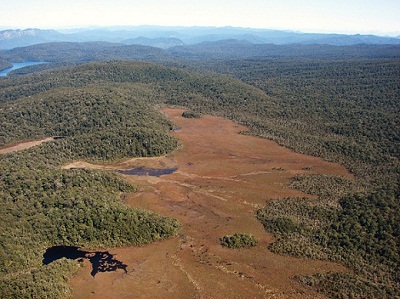UK Scientists Visit New Zealand for Collaborative Study into Past Climate Change
Two scientists from the University of Exeter in the UK, working in collaboration with Victoria University of Wellington are currently visiting New Zealand to undertake fieldwork on a new project that eventually aims to study how New Zealand’s climate has changed over the past 10,000 years.
Two scientists from the University of Exeter in the UK, working in collaboration with Victoria University of Wellington are currently visiting New Zealand to undertake fieldwork on a new project that eventually aims to study how New Zealand’s climate has changed over the past 10,000 years.
Prof Rewi Newnham (VUW) and Prof Dan Charman and Dr Matt Amesbury (UoE) are experts in peat bog ecosystems, with which New Zealand is abundantly endowed. They use cores from bogs, drilled down through many thousands of years of gradually accumulated peat, to study how and why climate has changed in the past. This type of research is an important element in the scientific drive towards understanding and predicting how climate may change in the future.
Funded by the UK’s Natural Environment Research Council, the team, will travel the length of the country this November, visiting six different peat bogs from near Kaitaia in the far north to near Invercargill in the far south. An important focus of their study is the bog wire rush, Empodisma, and understanding how the plant incorporates a record of climate into its tissues as it grows, dies and eventually forms the peat that the bogs are made of.

“We can study past climate change by looking at the isotopes captured in the plant tissues,” Dan Charman explains further. “Isotopes are atoms of the same element that contain different numbers of neutrons, making them either heavier or lighter. The isotope signal in bogs comes from the precipitation that plants use to construct cellulose, an organic compound that forms their cell structure. We can relate this to climate because, under different climatic conditions, lighter or heavier isotopes are more common in rain”.
Matt Amesbury explains the purpose of their field campaign; “We’ll be visiting bogs located throughout New Zealand to take samples of the wire rush from locations experiencing different climate regimes. These samples, plus others we will be collecting every month over the coming year with the help of our colleagues in New Zealand, will help us understand if we can use the isotope method in these sites to study how climate has changed in New Zealand since peat began to accumulate many thousands of years ago.”
If the method proves successful, then future research will involve taking a number of peat cores to apply the method to records stretching back many thousands of years. This will allow the team to study the past influence of precipitation, particularly of the Southern Westerlies, on New Zealand’s climate, which is something that is very difficult to do using current methods. The team have joined up with the OurFuture website (ourfuture.net.nz), run by NZ Crown Research Institute Landcare, to write stories and blogs as their fieldwork progresses and they encourage you to follow their progress!
